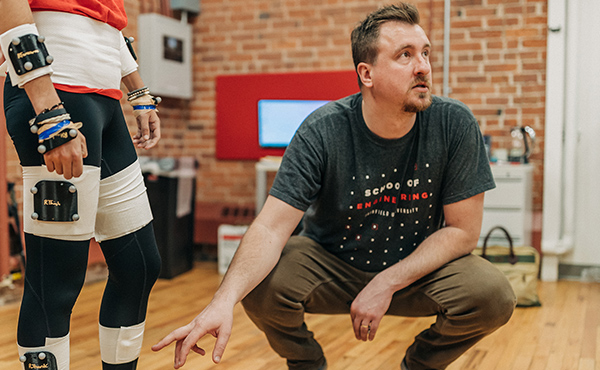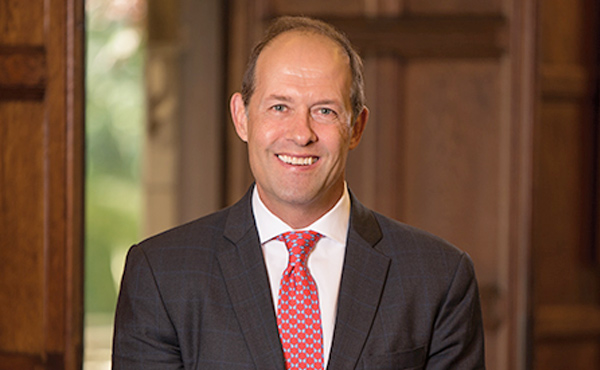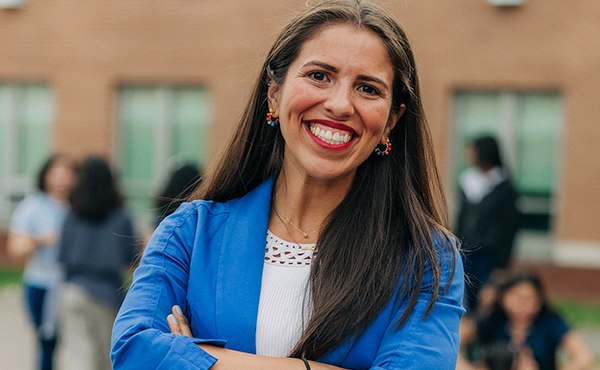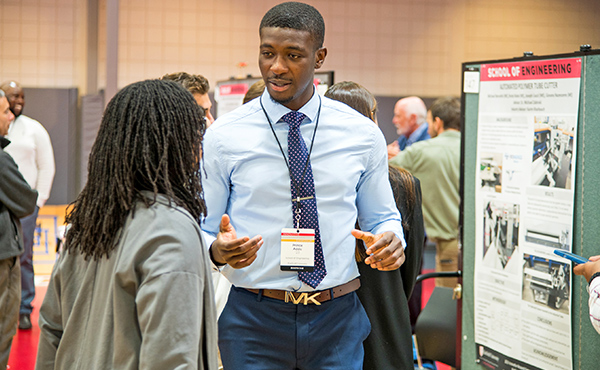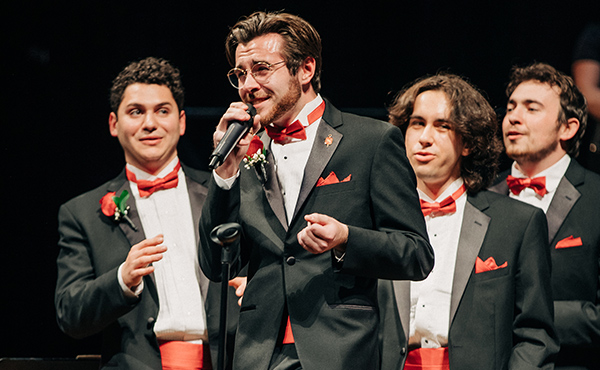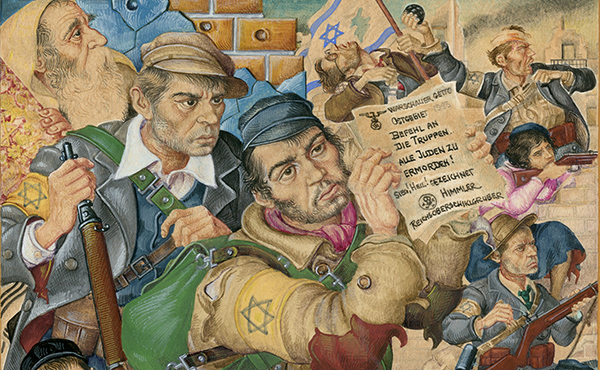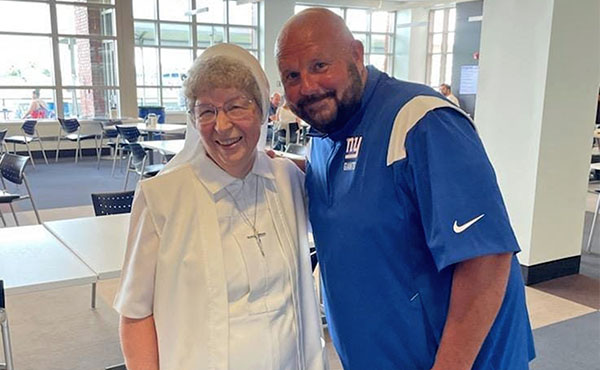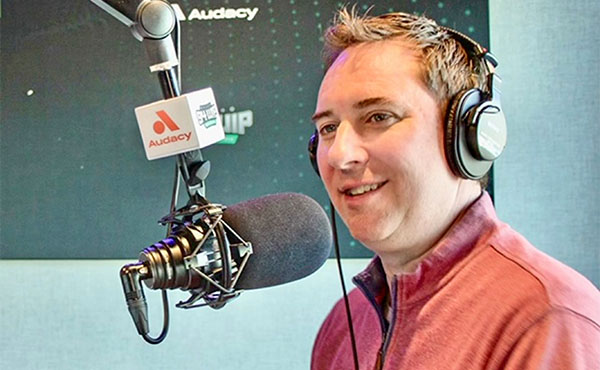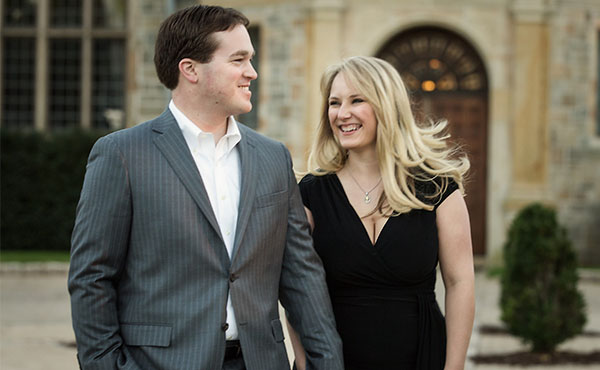John Drazan and his teams of biomedical student researchers are studying athletic performance in the lab, and outside.
One of my favorite things that I ask my students is: How would you describe walking to an alien who has no idea what walking is? My favorite answer to this is: Falling forward repeatedly and catching yourself.
— John Drazan, PhD, Assistant Professor of Biomechanical Engineering
One morning this past spring, School of Engineering graduate assistant and former Division I field hockey player Laia Vancells-Lopez was wearing electromyography sensors attached to her body to measure muscle activation patterns in her lower leg.
The exercises she was performing were part of an ongoing biomechanical engineering study in the Community Situated Biomechanics Lab, located at the new Innovation Annex on the southwest corner of campus.
Vancells-Lopez completed a series of jumps and exercises while assistant professor of biomechanical engineering John Drazan, PhD, and fellow graduate assistant John Minogue viewed the data on a large screen on the lab’s back wall.
Their research is focused on musculoskeletal biomechanics — the study of how people move, how they get injured, and how to prevent injuries. It is a subject Dr. Drazan is deeply passionate about.
He is not your ordinary engineer researcher. A former college basketball player, Dr. Drazan wasn’t originally interested in pursuing a career in the STEM field. That all changed when his high school physics teacher showed him how to apply physics to sports.
“He introduced me to the entire field of sports science, and all of a sudden I knew why I had been learning calculus and physics. I could use the impulse momentum theorem (a formula for calculating how the power of an impulse translates into action) to calculate how high I could jump, based on the force I’m producing. Or, use parabolic arcs to understand how the ball goes into the basket when I take a jump shot. This was transformative for me.”
“Sports, and studying sports through a scientific lens, was the spark that led me into my entire career,” he continued, “so being able to do biomechanics research now professionally, both for musculoskeletal health and sports performance, is outrageously exciting.”

Graduate assistant Laia Vancells-Lopez completes a series of jumps and exercises to activate muscle patterns in her lower legs.
The Achilles tendon, Dr. Drazan’s particular area of research, is a band of tissue vital to ankle biomechanics and general human movement. Used to transfer forces from the triceps surae — the calf muscles — to support the leg during stance phase in walking and running, it also stores energy then releases it when you take a step forward.
“One of my favorite things that I ask my students is: How would you describe walking to an alien who has no idea what walking is?” said Dr. Drazan. “My favorite answer to this is: Falling forward repeatedly and catching yourself.”
The ankle, he explained, rotates when you’re tipping forward. This energy is stored in the tendon, then released to push yourself forward to be caught by the other leg – offering humans a very energy-efficient mode of locomotion. “Understanding how the triceps surae and the Achilles tendon mediate this walking pattern, both in healthy and unhealthy people,” he noted, “is very important to helping people maintain their quality of life.”
Dr. Drazan’s research asks questions about how physical activity patterns influence muscular structure and function over the life span. “Is [professional basketball player] LeBron James who he is because this was who he was always destined to be?” he debates, “Or did his activity patterns during development influence his final muscular structure and functions?”
His goal is to conduct long-term studies in musculoskeletal development within athletic populations, to better understand how physical activity patterns early in life may lead to the development of pathologies like Achilles tendinopathy or tendonitis later in life.
In a concurrent study, Dr. Drazan is collecting data from subjects to analyze the differences in the Achilles tendon loading pattern between older and younger basketball players.
Most commonly, people experience an Achilles tendon rupture mid-stance, and most often it happens in recreationally active males between ages of 30 and 50. “Is this pattern due to an intrinsic change within the tissue, such as degradation of the tendon quality,” Dr. Drazan ponders, “or is it due to changes in loading patterns due to heavier weight? We are going to dig into that.”
Dr. Drazan collects data both in the lab and outside, using a combination of state-of-the-art equipment and lowcost, in-house designed mobile devices.
In the lab, the biomechanical engineering professor and his student research assistants use wireless electromyography devices to track activity patterns in muscles. Infrared cameras and motion tracking equipment record and digitize the movements of a person wearing reflective markers. The lab’s instrumented force plates measure the gravitational forces an individual applies during different movements. Outside the lab, Dr. Drazan and his students collect data using an instrumented insole sensor in the form of a shoe insert, called Loadsol.
To complement the use of these professional research tools, Dr. Drazan encourages the design of devices built by Fairfield engineering students. “One of the great things about being at Fairfield is working with undergrads and inviting them to help me solve problems we face in research,” he said.
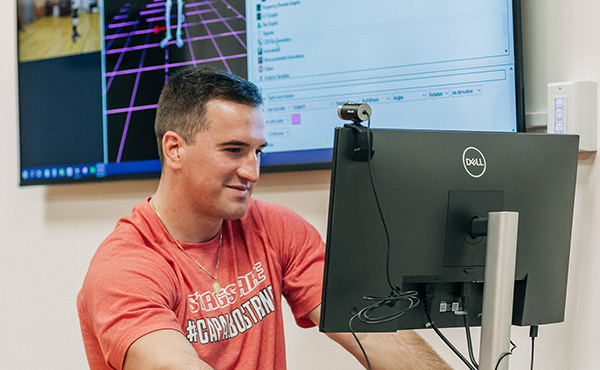
Graduate assistant John Minogue analyzes data in real-time.
For example, three of his students: Dominic Olivieri ’23, Julia Kilroy ’23, and Conor Landry ’23, designed an instrumented walking pole under his guidance. Assistive walking poles are commonly used by post-surgical patients and those with injuries; they work by redistributing weight load from the lower body to heal injuries. The student design team hopes their device can be studied in the lab to determine its effect on loading patterns during use.
Another senior design team made up of Conor Landry ’23, Omar Jack ’23, Alex Hemmat ’23, and Eric Hawkinson ’23, worked with Dr. Drazan to create a series of portable, do-it-yourself (DIY) assessment tools that measure a student’s athletic performance through drills that mimic the NBA Draft combine — an event where prospective rookies are tested and evaluated to assess athletic ability.
This year, Dr. Drazan and the students brought their DIY technology to sporting events across the nation, culminating with a trip to the NBA All-Star Weekend in Salt Lake City, Utah. There, they worked in partnership with project sponsor 4th Family Inc., teaching 250 student participants about muscle memory, fast-twitch muscle fibers, and data collection, while demonstrating how STEM and athletics work together.
This type of community outreach, noted Dr. Drazan, reaches students who are underrepresented in STEM, and who – like himself in younger years – may not have awareness or interest in the field.
“One of the reasons I love engaging youth in STEM in the context of sports, is that young athletes are filled with questions about how to get better at their sport,” he said. “When we do programs that engage students in math and science through sports performance training, it’s a natural match and it allows us to engage new populations in STEM.”
